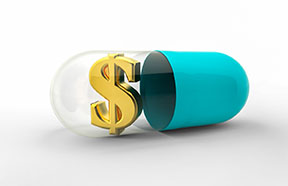

Take Control of Prescription Costs
Prescription drug costs have become so expensive many patients are having to decide between filling a prescription or not taking it all.
The U.S. Department of Health and Human Services (HHS) reports that almost half of Americans take at least one prescription medicine and one in six are taking three or more medications. Of those taking medications, nearly one in four Americans find it difficult to pay for their prescriptions, according to 2019 KKF Tracking Poll researchers.
If you're tired of waiting for Congress or drug companies to lower costs, the good news is there are steps you can take now to control the expense of prescriptions.
Insurance
First, check your insurance company’s formulary — a list of drugs your insurance company will cover on your plan. If the drug is not covered and you cannot afford the cost, call the insurance company and ask if there is a similar medication that your plan covers.
Don't assume purchasing a drug through your health insurance will be cheaper, in some instances the out-of-pocket cost may be less than your co-pay.
Split Pills
Ask your doctor if a higher dosage pill can be split. Some insurance companies charge based upon the quantity of medications — not the strength. Doubling the strength of a medication and cutting it in half means you only will be charged for half the tablets. However, coated pills and time-release drugs usually should be taken whole.
Generic Drugs
Ask your doctor to write a prescription for the generic version of the medication if the brand name is expensive. Many generic medications have the same active ingredients as brand-name drugs, but usually at a much lower cost. You also can ask your pharmacist about generic alternatives. Some pharmacists will automatically fill the prescription with a generic if it's available.
Generics can be even more affordable through mail-order programs or through grocery stores and big-box retailers — some of which offer $4 generics.
Although generics usually are cheaper, there are exceptions. It pays to do the research.
Larger Supply
When you know you'll need to take a medication for at least three months, ask if your doctor will write you a prescription for a 90-day supply. You usually can save money by purchasing the medication in larger quantities. Some retailers offer a 90-day supply of generics for as little as $10.
Compare Prices
Not all pharmacies charge the same amount for a medication, so call various pharmacies, big box retailers and grocery stores to find the best price.
Discount Savings Programs
You can often find discount coupons online. Just type in the name of the prescription, set your location, and search nearby pharmacies and see if they have a free discount prescription card.
Coupons
Often manufacturers of brand-name drugs will offer rebates. To determine whether there’s a rebate program for a medication you take, go to the medication’s website or do a web search for the name of medication and manufacturer's rebate.
Financial Assistance
You may qualify for state or local government prescription drug assistance. Some stores and pharmacies offer their own free prescription drug programs and you may be eligible to receive free antibiotics or free medications for high blood pressure and diabetes.
Medicare Part D Prescription Drug Plan
Those who are enrolled in either Medicare Part A or Part B (or both) can purchase a Medicare Part D prescription drug plan as a stand-alone policy to reduce their out-of-pocket expenses.
Mail Order Pharmacy
Check with your insurance company to see if they have a partnership with a mail order pharmacy. These services often have less overhead compared to a local pharmacy and therefore can afford to sell medications at a cheaper price. They also can be convenient because they can deliver your prescriptions to your front door.
Many health insurance companies also work with a pharmacy benefits manager (PBM). A PBM helps employees get prescription savings — usually through a mail-order program.
Samples
Did you know that drug sales representatives often leave samples with doctors to give to their patients. If your doctor doesn’t offer samples, ask!
Free Prescriptions
Some retailers offer free antibiotics with a prescription as a way to entice shoppers. Since you’re not required to purchase anything besides the drug, you end up getting two for one.
Expanded Access or Compassionate Use
To help people with serious or life-threatening conditions gain access to experimental medications, the Food & Drug Administration has an Expanded Access (Compassionate Use) program. The applicant must meet various criteria, including having a serious disease or condition or whose life is immediately threatened by their disease or condition. There also must be no comparable or satisfactory alternative therapy to diagnose, monitor or treat the disease or condition.
[return to top]
Should You Use Your Credit Card to Pay Your Medical Insurance Premiums?
Think You’re Too Old for Life Insurance? Think Again!
The information presented and conclusions within are based upon our best judgment and analysis. It is not guaranteed information and does not necessarily reflect all available data. Web addresses are current at time of publication but subject to change. SmartsPro Marketing and The Insurance 411 do not engage in the solicitation, sale or management of securities or investments, nor does it make any recommendations on securities or investments. This material may not be quoted or reproduced in any form without publisher’s permission. All rights reserved. ©2021 The Insurance 411. www.theinsurance411.com Tel. 877-762-7877.